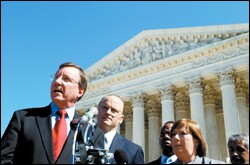
The U.S. Supreme Court delved into the complexities of federal special education law last week as it took up a case involving the burden of proof in disputes over individualized education programs.
Justice Stephen G. Breyer called the case before the court a “law professor’s dream,” because a hearing officer reviewing a dispute between a family and the 139,000-student Montgomery County, Md., school district found their arguments to be equally balanced, which made the outcome hinge on which side had the burden of proof.
Congress has never explicitly said which side has the burden of proof in such disputes about a child’s special education plan under the federal Individuals with Disabilities Education Act. But several states have assigned the burden to one side or the other, either through state laws or through rulings by their state courts.
Like most states, however, Maryland has not assigned the burden of proof, which in the law is the responsibility of proving a disputed fact or assertion.
The outcome of Schaffer v. Weast (Case No. 04-698) could affect the negotiating power of school districts and the parents of the more than 6 million children in special education programs across the country, as they formulate the individualized education programs, or IEPs, that the law requires for students with disabilities.
Although only a small percentage of IEPs are disputed, districts spend more than $146 million annually in mediation, due-process hearings, and litigation over special education placements nationwide, according to a 2003 study by the American Institutes of Research.
Interest in the case among education organizations is high, because it has been several years since the Supreme Court has considered a case involving the IDEA, which was most recently reauthorized in 2004.
In the one-hour oral arguments on Oct. 5, the justices themselves showed lively interest in the case. The high court’s recent change in leadership also piqued observers’ curiosity, but new Chief Justice John G. Roberts Jr. did not participate in the argument.
Although he did not announce why he was apparently recusing himself, court watchers noted that a lawyer from his former law firm, Hogan & Hartson, argued for the school district, and that Mr. Roberts was working at the Washington-based firm at the time the case originated.
‘Equal Partnership’
Brian Schaffer, the student at the center of the case, had been diagnosed with attention deficit hyperactivity disorder and other disabilities was due to enroll in a middle school in Montgomery County, after attending a private school. But his parents, Jocelyn S. Schaffer and Martin P. Schaffer, did not accept the school district’s recommended placement of Brian in special education services at a regular school, and enrolled him in another private school as they continued to negotiate with the district. Later, they accepted the district’s placement of their son at a high school. He graduated from the school and now attends college. (“Best Evidence,” Sept. 28, 2005)
William H. Hurd, the lawyer representing the Schaffers, told the justices that the Department of Education’s regulations for the IDEA make the creation of an individualized education program “an equal partnership” between the parents and the school system. The greater resources and expertise of the school district make it fair that the district assume the burden of proof in most cases, he argued.
But several justices seemed concerned that placing the burden of proof on the district would subject a school system to the whims of parents who might initially agree with an IEP but later change their minds and seek to have the district pick up the costs for a private school placement for their child.
Mr. Hurd told the justices that if an IEP proposed by the district was erroneous, a fleeting opportunity to educate a child with disabilities could be lost. Giving parents more leverage would, “if the hearing officer makes a mistake and awards services that are not really needed,” merely give the child a somewhat better education than normal.
That drew a sharp question from Justice John Paul Stevens. “Isn’t it true,” he said, “that many of these fights take place after the child has finished school?”
At another point in the session, Mr. Hurd argued that, even if consensus broke down, Congress intended for the child to have an IEP.
“In baseball, the tie goes to the runner,” he said. In special education cases, he added, “when the evidence is in equipoise, the tie should go to the child.”
‘Default’ Rule
Representing the Montgomery County school district, in suburban Washington, Gregory G. Garre noted that, by not specifying which side bears the burden of proof, the IDEA allows the states to pass laws that place the burden on either party, and that several have.
He asked the court to create a “default” rule, placing the burden of proof on the party bringing the complaint, when the states have not assigned the burden to one side or the other.
Mr. Hurd said the issue was important in the enforcement of students’ rights under the IDEA.
“If you let the school systems slide by without being accountable, they’re likely to be less thorough,” he said.
The justices seemed very interested in a statistic cited by Assistant Solicitor General David B. Salmons, who argued for the Bush administration in support of the school district.
According to a 2003 report by the Government Accountability Office, he said, 80 percent of all IDEA due-process hearings occur in just six jurisdictions—five states and the District of Columbia.
The National Council on Disability reported that eight states and the District of Columbia have placed the burden of proof on the school district, either by rule or by court decision.
A decision in the case is expected by next July.




